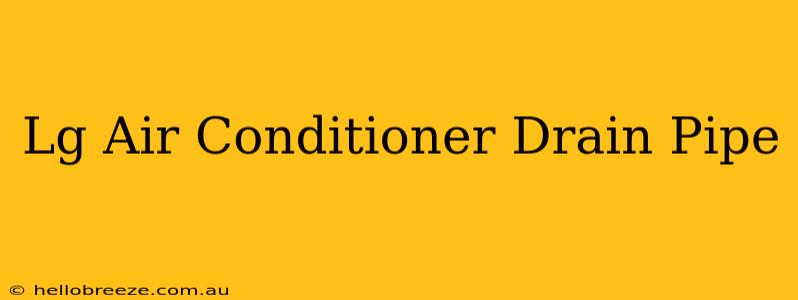Is your LG air conditioner leaking? A clogged or damaged drain pipe is a common culprit. This comprehensive guide will walk you through identifying problems, troubleshooting solutions, and maintaining your LG AC's drainage system for optimal performance and a leak-free home.
Understanding Your LG Air Conditioner's Drainage System
LG air conditioners, like most, use a drainage system to remove condensation. This water is a byproduct of the cooling process. The condensate collects in a pan and is then typically drained through a pipe. A properly functioning drain pipe is essential to prevent water damage and ensure your AC unit operates efficiently.
Key Components of the Drainage System:
- Condensation Pan: This is where the water collects. Regular cleaning prevents clogs.
- Drain Hose/Pipe: This carries the water away from the unit. Check for kinks, clogs, or damage.
- Drain Pump (some models): Some LG AC units, especially those installed in unusual locations, use a pump to assist with drainage.
Common LG Air Conditioner Drain Pipe Problems
Several issues can arise with your LG air conditioner's drain pipe, leading to leaks or inefficient operation.
1. Clogged Drain Pipe:
This is the most frequent problem. Debris, algae, and mineral buildup can restrict water flow, causing overflow.
Symptoms: Water pooling around the unit, slow drainage, or a musty odor.
2. Kinked or Damaged Drain Pipe:
A kinked or broken pipe prevents proper drainage. This is common during installation or if the pipe is accidentally bumped or moved.
Symptoms: Water leakage, inconsistent drainage.
3. Incorrect Slope:
The drain pipe needs a slight downward slope to ensure proper water flow. If the slope is insufficient or reversed, water won't drain correctly.
Symptoms: Slow or no drainage, water pooling.
4. Frozen Drain Pipe (in colder climates):**
In freezing temperatures, water in the drain pipe can freeze, creating an ice blockage.
Symptoms: Reduced cooling, water leakage, and ice formation around the unit.
5. Faulty Drain Pump (if applicable):**
If your LG AC has a drain pump, a malfunctioning pump can prevent proper drainage.
Symptoms: Water pooling, no drainage despite a seemingly clear pipe.
Troubleshooting Your LG Air Conditioner Drain Pipe
Before contacting a professional, try these troubleshooting steps:
1. Check for Clogs:
Carefully inspect the drain pipe for clogs. Use a wet/dry vacuum, a drain snake, or compressed air to clear any blockages. Remember to disconnect the power to your AC unit before cleaning.
2. Inspect for Kinks and Damage:
Examine the entire length of the drain pipe for kinks or damage. Gently straighten any kinks. Replace any damaged sections.
3. Verify Proper Slope:
Ensure the drain pipe has the correct downward slope. Adjust the pipe as needed.
4. Check the Drain Pan:
Clean the condensation pan to remove any debris that might be interfering with drainage.
5. Inspect the Drain Pump (if applicable):**
If your unit has a drain pump, verify it's working correctly. Consult your LG AC user manual for troubleshooting instructions specific to your model.
Preventing Future Drain Pipe Problems:
Regular maintenance is key to preventing drain pipe issues.
- Clean the drain pipe regularly: At least once or twice a year.
- Inspect the pipe for damage: Check for kinks or cracks during routine inspections.
- Ensure proper slope: Confirm the drain pipe has a sufficient downward slope.
- Protect the pipe from damage: Keep the pipe from getting crushed or bumped.
When to Call a Professional:
If you've tried the troubleshooting steps and are still experiencing drainage problems, it's best to contact a qualified HVAC technician. Complex issues like a faulty drain pump or major pipe damage require professional expertise. Attempting repairs without proper knowledge could void warranties or even cause further damage.
By understanding your LG air conditioner's drainage system and performing routine maintenance, you can prevent costly repairs and ensure your AC runs efficiently and effectively for years to come. Remember, a well-maintained drain pipe is a key component of a healthy and leak-free air conditioning system.

